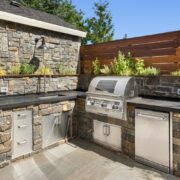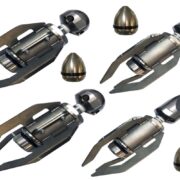If you’re buying an older home, chances are, there’s a wood burning fireplace inside. Installing a wood burning fireplace in a new home is against the law in most states, but there are many older fireplaces grandfathered in.
Because wood-burning fireplaces are not common in newer homes, you might be unfamiliar with their construction and operation. They can create amazing ambiance and offer a heat source in times of electricity outages, but they pose more risks than gas or electric fireplaces. To operate your fireplace safely and efficiently, here are seven things you need to understand.
Table of Contents
You need a chimney cap.
A chimney cap is installed on top of your chimney to prevent any blockages that prevent the smoke from venting out of the home. Without a cap, debris from overhanging trees can fall into it, or animals can build nests inside, preventing safe air flow when you have a fire.
Finding the right chimney cap can be confusing, so use this handy guide and size calculator to help you choose.
The chimney should be regularly maintained.
If you never use your fireplace, having it cleaned and maintained isn’t necessary. If you decide to use it, you should have it cleaned and repaired (if necessary) if it’s been unused for some time.
If you use your fireplace regularly, have it cleaned at least twice per year. Soot, ash, creosote, and debris can build up in the chimney and flue, preventing safe air passage.
Not all wood is created equally.
For an indoor fireplace, the type of wood you use matters. For a clean burn with minimal smell and chemical release, only burn real firewood (not lumber or crates) that has been “seasoned” or dried for 6-12 months. Not only will this protect the air quality in your home, but it will also reduce creosote buildup in the chimney.
You need a place to properly store your wood.
Proper wood storage is essential for a nice, crackling fire. It should be kept in a dry place with good air circulation to help keep the wood dry. For this reason, placing wood in a shed or covering it with tarps is not the best option.
Ideally, you’ll place your wood underneath a pavilion of sorts with open sides. It should be stacked on pallets or rows of extra lumber so that air can circulate beneath it, and it won’t soak up moisture from the ground.
Additionally, do not store wood under and attached carport, in the garage, or within 10 feet of the house to prevent pest infestations.
Wood burning fireplaces are not typically considered energy efficient.
Many people believe that if they burn wood in their fireplace alongside heating their home with gas or electricity, it will save them money. However, most wood burning fireplaces are highly inefficient.
Consider the overall efficiency of your fireplace, which “is the percentage of heat that is transferred to the space to be heated when a load of fuel (e.g., firewood, pellets) is burned,” according to the EPA.
For most units, the overall efficiency is 10-20 percent or lower, meaning that it doesn’t transfer much heat to the interior of your home. It’s great for an emergency, but it doesn’t do much good in an everyday setting.
Understand how to operate the damper.
The damper is located just above the firebox, and it closes off the chimney when it’s not in use. When the fireplace is not being used, it prevents exterior air from gusting down the chimney and into your house.
When in use, the damper must be open for your safety. Otherwise, smoke will flood your home, making the air unbreathable and increasing the risk of a fire. Regularly have your damper inspected and make repairs as necessary to maintain top safety and efficiency in the home.
Install smoke and carbon monoxide detectors and test them regularly.
If your chimney and firebox are properly maintained, the risk of a fire in the house is slim. Still, accidents happen, and you’ll want working smoke detectors on each level of your home.
All devices that put out combustion fumes produce carbon monoxide (CO), including your wood burning fireplace. Usually, the CO burns up and is harmless. However, incorrect operation, installation, or ventilation can result in CO infiltrating your home. Carbon monoxide is an odorless and tasteless poisonous gas that’s deadly when inhaled, and the only way to detect it is with CO detectors on each level of the home.
For your own safety, convenience, and comfort, learning all you can about owning and operating a wood burning fireplace is vital. When you’ve become an expert, you can enjoy this timeless feature of your home for years to come!













Comments